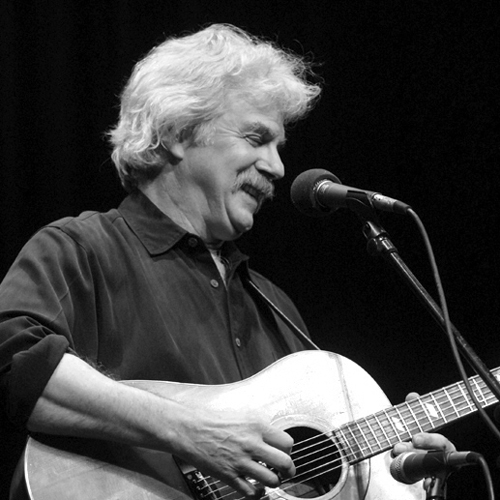Tom Rush
What a resume! In broadest outline, Tom Rush was a leader in the folk boom of the 1960s & 1970s, progressing from performing traditional folk and blues to coupling folk and electricity into folk-rock, then to singing original compositions and outstanding songs by temporarily obscure young singer-songwriters. He formed his own record label way before it was fashionable, has been steadily touring for much of the last 40+ years, and, as in his repertoire, mixed well-known and fledgling songwriters in a traveling “Club 47” concert series for more than two decades. And we owe it all to testosterone: “I was inspired to start performing by the desire to meet girls,” says Tom.
Born in Portsmouth, NH, in 1941, Rush was forced to take piano lessons as a child and hated them. But his cousin, the wonderfully named Beau Beals, taught him how to play ukulele, and that’s when he “decided that music could be fun … The ukulele morphed into a guitar during the high school years because it seemed more likely to impress girls.” Tom not only had a rock ‘n’ roll band, The Chasers, in school, but was also volunteered by his mother to lead a band of inmates at the local mental institution. “Everyone wore street clothes – the doctors, the patients, me – so you didn’t know who was whom,” Rush recalls.
Originally a fan of late-’50s rockers Elvis Presley, Chuck Berry and Little Richard, Tom heard a recording by the great folk-blues singer Josh White on a family trip through Wyoming, a transformative experience. “I knew I had to become just like him. Then came the Kingston Trio, but I didn’t like the shirts; then Odetta. Basically, I picked up a little from just about everyone I listened to. Eric von Schmidt was a major influence once I got to Cambridge,” where Tom had enrolled, and eventually graduated, as an English Lit major.
Rush became an integral part of the Boston/Cambridge folk scene of the very early-1960s, recording his first album, Live at the Unicorn, in 1962 on a tiny label that almost immediately folded. He played the coffeehouse circuit in the Boston area, becoming a regular at the seminal Club 47, and recorded two albums of folk-blues standards for the Prestige label in 1963. After commuting to New York’s Greenwich Village to perform, Rush moved there around 1966, after the release of his self-titled 1965 album for Elektra. In 1966, Elektra issued Tom’s Take a Little Walk with Me, with its influential mixture of mostly traditional folk-blues songs on one side and an electric band featuring Dylan sidemen Al Kooper, Bruce Langhorne and Harvey Brooks that rocked up songs like Bo Diddley’s “Who Do You Love,” Chuck Berry’s “Too Much Monkey Business,” and Tom’s first recorded original, “On the Road Again.”
Tom’s next album for Elektra was a turning point for him and for the entire contemporary music scene. The Circle Game (1968) showcased the first recorded versions of three songs by then-unknown Joni Mitchell, two songs each by the equally unsung rookies Jackson Browne and James Taylor, and what remains Rush’s signature song to this day, the grave, brave, regret-filled “No Regrets.”
Moving from Elektra to Columbia, Rush continued his pattern of recording distinctive vocals and personalized, definitive arrangements of original and “discovered” songs, expanding his pallet into country-rock in some instances. In 1970, Tom and his backing band joined the rock ’n’ roll circus known as the Festival Express, a brief tour-by-train in which concerts were almost an afterthought to the hard-partying aboard, whose participants included the Grateful Dead, Janis Joplin, Buddy Guy, Delaney & Bonnie & Friends and future Appleseed label-mate Eric Andersen, among others.
By 1974, after the release of his Ladies Love Outlaws album, Rush decided to drop out of the touring/recording cycle for a while – after catching his breath, he soon resumed touring, but his only recordings for the next ten years were a pair of live albums recorded at Boston’s Symphony Hall on his own Night Light Recordings (while Columbia and Elektra issued various “best-of” collections). These concerts, first staged in 1981, were so successful that they became annual holiday events – “the Club 47 series” – in which Rush invited old and new musical friends to join him on stage, mixing established stars such as Bonnie Raitt, Emmylou Harris, Joan Baez and Richie Havens helping to introduce newcomers Nanci Griffith, Alison Krauss, Shawn Colvin, and Mark O’Connor, among others, to wider audiences. Some of the concerts were broadcast by NPR and PBS. Rush took the show on the road, selling out Carnegie Hall, Washington’s Smithsonian Institute and Kennedy Center, and many other prestigious venues. Tom still tours the country regularly with his own solo shows, and a live clip of him on YouTube performing the hilarious “Remember Song” has drawn more than 3.5 million plays, so he’s reaching a wider audience than ever.
Relocating to New Hampshire in 2008 after stints in California and Wyoming, recording What I Know, his first studio album in 35 years, keeping the musical torch burning with his generous folk spirit, what Tom Rush knows is how to write, choose and sing a song, how to make an audience believe every word he sings, and how to make everywhere feel like home.
To read James Reed’s in-depth Boston Globe interview with Tom Rush about Tom’s new CD, please follow this link.
For an itinerary of Tom’s upcoming performances, click HERE.
Showing all 4 results





